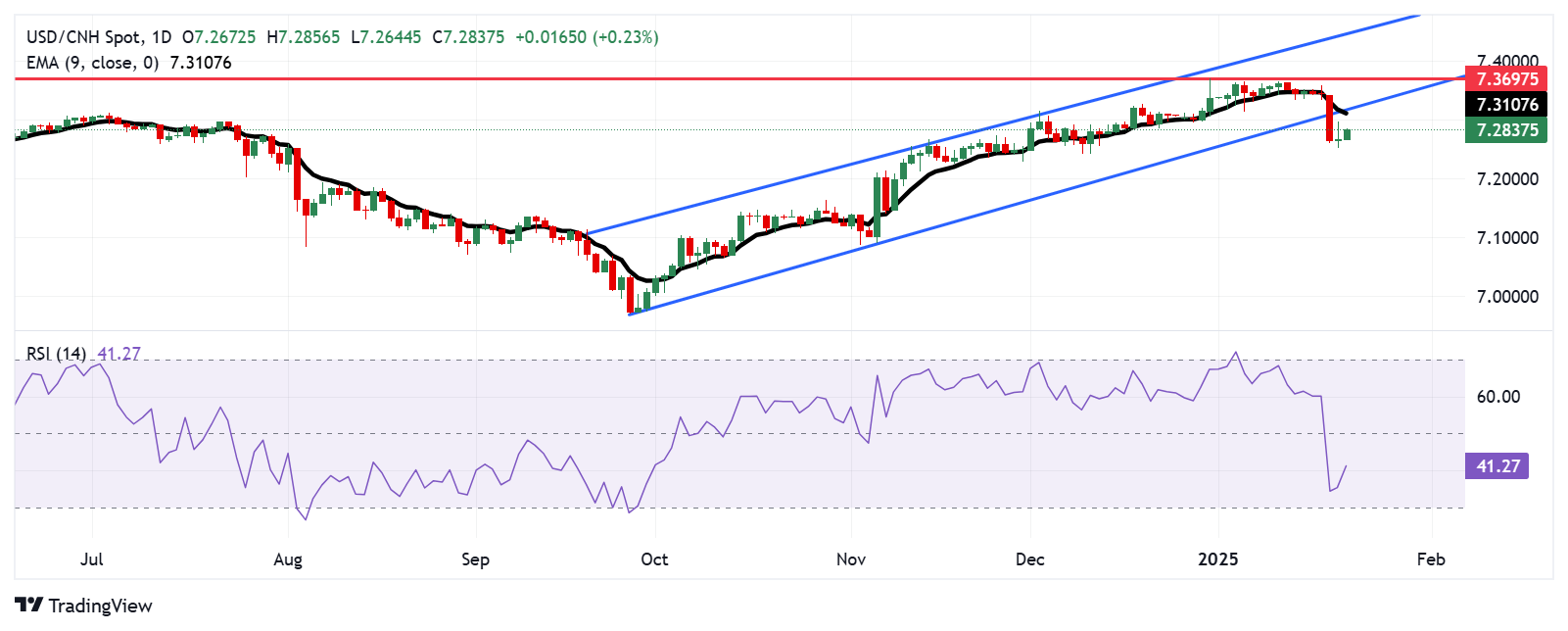USD/CNH rises above 7.2800 as Chinese Yuan weakens due to Trump’s tariff threats
- USD/CNH appreciates as the Trump administration considers imposing a 10% tariff on Chinese imports.
- Chinese Vice Premier Ding Xuexiang warned about the consequences of a trade war.
- The pair could encounter the initial barrier near the critical zone around nine-day EMA at the 7.3108 level.
USD/CNH, representing the offshore Chinese Yuan, extends its gains for the second successive day on Wednesday. The pair's upward momentum is driven by an announcement from former US President Donald Trump, stating that his administration is considering imposing a 10% tariff on Chinese imports starting February 1. According to Reuters, this move is linked to concerns over fentanyl shipments from China to Mexico and Canada.
While the proposed 10% tariff is significantly lower than the previously threatened 60% rate, it aligns with the pledge Trump made during his presidential campaign. This announcement follows a recent phone call between Trump and Chinese President Xi Jinping, during which they discussed trade, fentanyl, and other key issues.
Chinese Vice Premier Ding Xuexiang issued a warning on Tuesday about the repercussions of a trade war, emphasizing that "there are no winners" in such conflicts as China faces the possibility of tariffs under Donald Trump's newly elected government, according to CNBC.
USD/CNH rises toward 7.3100 barrier to re-enter the ascending channel
The USD/CNH pair trades near 7.2820 during Asian hours on Wednesday. A review of the daily chart shows the price moving upward toward the existing ascending channel pattern, signaling a potential recovery of bullish bias.
However, the 14-day Relative Strength Index (RSI), a key momentum indicator, remains below the 50 mark, indicating persistent bearish momentum. Any further improvement in the RSI could suggest the development of a bullish bias.
On the downside, the USD/CNH pair may target the psychological support level at 7.2000 level.
The USD/CNH pair might struggle to re-enter the ascending channel, encountering initial resistance near the critical zone at the channel's lower boundary and the nine-day Exponential Moving Average (EMA), positioned at the 7.3108 level.
USD/CNH: Daily Chart
PBOC FAQs
The primary monetary policy objectives of the People's Bank of China (PBoC) are to safeguard price stability, including exchange rate stability, and promote economic growth. China’s central bank also aims to implement financial reforms, such as opening and developing the financial market.
The PBoC is owned by the state of the People's Republic of China (PRC), so it is not considered an autonomous institution. The Chinese Communist Party (CCP) Committee Secretary, nominated by the Chairman of the State Council, has a key influence on the PBoC’s management and direction, not the governor. However, Mr. Pan Gongsheng currently holds both of these posts.
Unlike the Western economies, the PBoC uses a broader set of monetary policy instruments to achieve its objectives. The primary tools include a seven-day Reverse Repo Rate (RRR), Medium-term Lending Facility (MLF), foreign exchange interventions and Reserve Requirement Ratio (RRR). However, The Loan Prime Rate (LPR) is China’s benchmark interest rate. Changes to the LPR directly influence the rates that need to be paid in the market for loans and mortgages and the interest paid on savings. By changing the LPR, China’s central bank can also influence the exchange rates of the Chinese Renminbi.
Yes, China has 19 private banks – a small fraction of the financial system. The largest private banks are digital lenders WeBank and MYbank, which are backed by tech giants Tencent and Ant Group, per The Straits Times. In 2014, China allowed domestic lenders fully capitalized by private funds to operate in the state-dominated financial sector.



